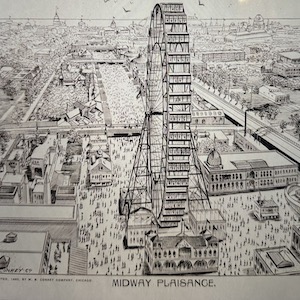The World's Fairs
The World's Fairs archive is a treasure which offers information on all aspects of the World Fairs and Expositions spanning 1851-2015. Its particular strength is Northern European and North American expositions from 1880 to 1920. This unique digital collection provides users with full-color primary source materials from 13 archives (such as the Bancroft Library, University of California Berkeley; Historical Society of Pennsylvania; and the New York Public Library, etc.), including correspondences, diaries, oral histories, government reports and official records, scrapbooks, sheet music, pamphlets, periodicals, and more.
The archive is easy to navigate and is organized into sections. A banner at the top of the homepage lists headings - "Introduction," "Fairs," "Documents," "Explore," "Image Gallery," and "Help" - alongside a search box. Below the search box on the top right is a link to advanced and popular searches. There is also the option to limit the search by fair title, personal names, date, document type, countries, archives, and case studies. The main portion of the site —the "documents" section —allows users to search the collection by keyword and filter by document type, country, case study fair and participating archive. Examples of engaging primary sources include a one-franc ticket and guide to the 1889 Exposition Universelle in Paris, a booklet of facts from the 1933 Century of Progress International Exposition in Chicago and a souvenir book from the 1937 Great Lakes Exposition. Each item is thoroughly and carefully described by providing the metadata of title, date, place, fair, owning archive, and description of visual content. For education purposes, students can view thumbnail images, rotate the content, download the entire file or just the images as PDF, and copy or export citations in MLA format to Zotero.
Under the section "Fairs," researchers can explore the twelve fairs chosen to serve as case studies and considered to be representative of the most influential exhibitions, including London's 1851 Great Exhibition of the Works of Industry of All Nations; the 1876 Centennial International Exhibition in Philadelphia; and the 1915 Panama-Pacific International Exposition in San Francisco. This tab is especially useful for the informative and engaging descriptions of each fair, by clicking the hyperlinks of each fair, users can explore all types of materials that relate to the selected fairs. The tab "Fairs Search Directory" and "The Attractions Search Directory" leads to an easy-to-navigate listing of all World Fairs and attractions. This section offers students a comprehensive insight into the fair, from the earliest planning stages to the legacy it leaves behind, and represents multiple perspectives including the official, the corporate and the personal.
The section "Image Gallery" contains two subsections: "Visual Highlights," which allows users to explore the visual material from fairs through the centuries, including artifacts, front covers, illustrations, maps, photographs, posters, and postcards. Users can download images from any or all of the fairs to their Lightbox by creating an account on the site. The 360 Object Gallery allows students to zoom and rotate images of 3D objects such as souvenir cups, and thus students can "handle" the raw materials and historical objects. Users can also select "Display Options" to read further information on each item. Also, teachers can use ‘"Image Options" to save their selections and run a bespoke slideshow for teaching and presentations.
Another useful section is "Explore." Under this section, the "The Essays" tab includes seven commissioned academic essays to provide insight into the material in this resource and some of the key research themes surrounding world fairs. The "Sound Recordings" tab contains two collections of sound recordings with synced transcripts that provide personal accounts that reflect the experience of attending fairs, including radio broadcasts, interviews with attendees on the fair site, music performed at the fair and other addresses and interviews. The "Interactive Site Plans" enables users to view images of key pavilions and exhibits in context for five of the important fairs. "The Popular Searches" provides a page that lists the products, names and keywords occurring frequently in the documents to guide users quickly finding resources. The "External links" provides a brief summary and link to each institution, allowing users to perform further research. Finally, the "Key Exhibits" tab offers a way to browse the collection by subject identified by the editorial board as common and important across all the fairs including aeronautics, Fashion & Beauty, Transportation, Art & Architecture, Lifestyle, and Electricity.
In sum, The World's Fairs is highly recommended due to its uniqueness, depth, scope, and quality of presentation. This resource offers a unique insight into the phenomenon of international expositions. It also offers a fresh, relevant, and engaging angle for exploring the history of the nineteenth and twentieth centuries, from the fairs’ earliest plans to their public reception to their legacy in the present day. The impact of these global events can be examined in a comprehensive context. This database is an attention-grabbing and high-quality resource which offers history, sociology, gender studies, and art and design related source materials for high-school and college students.
